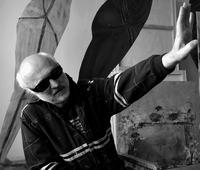Václav Bláha ... Back and There
Galerie 1. patro / 1st Floor Gallery
11 December 2013 - 18 January 2014
Curator Zdeněk Freisleben
The 1970s and 80s was a period of artistic growth primarily for the emerging generation – both individual artists and artistic groups, for example The Stubborn Ones or group 12/15.
One of the most distinctive artists of the society Free Coalition 12/15 Better Late Than Never is Václav Bláha. He belongs to the generation of artists who entered the art scene during a time that was very problematic for artistic production, both societally and politically. It is also here, under conditions of oppression, that we also find an artist seeking out the internal existential image of man. His pictures of the time, inclined, precariously balanced figures, are at the same time a symbol of the internal uncertainty of the individual.
The concentration on human fate, the variable landscape of experiences, emotions, doubts, but also shared happinesses can be found in another aspect of his artistic works. At the same time, however, he does not close himself off and concentrate on the intimate form, but precisely the opposite. Many of his achievements approach the monumental, not only in their format, but in their spatial arrangement as well. His installation in the German district of Eschlkam is a blending of images oscillating between earth and sky. His piece from 2001, Rivulet of my Youth, is not only a preserved record of objects, but also of time. Many of his images and installations are a frank testimony relating personal and physical experiences. At the same time, however, they also serve as a symbol of the universal reality of mankind.
The cycle Messages is yet another significant aspect of Václav Bláha’s work, in which he often employs brief texts. The artist focuses on peculiar communications with his surroundings. He thus imparts indications of his intimate feelings, which simultaneously assume external and universal significance. Later his Tales emerged as well, reflections of his own experiences and relationships. Often his paintings become and mere macrostructures –coloured expressions of planes and space.
At the exhibition, we also encounter diverse forms, from the merest gesture, as in the pictures Daybreak and Oh, my love…, to larger structural images such as Figural Landscapes. This seeming blurriness reveals further possibilities for Bláha’s work, which assume ever newer and innovative forms. It is obvious that even in this context his idiosyncratic apprehension of human life experiences remain a fundamental story he has constantly before his eyes.
Zdeněk Freisleben
While viewing the exhibition, you can listen to Václav Bláha’s commentary.
Image photos © Magdaléna Bláhová





